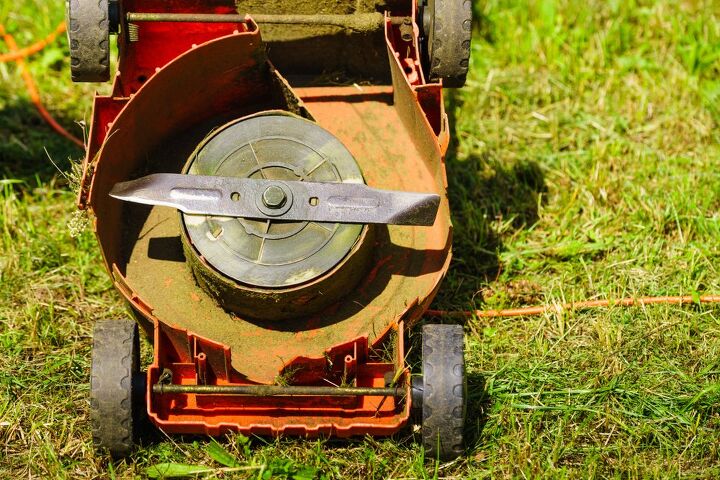5 Types Of Lawnmower Blades (With Photos)

Lawnmowers are an essential tool for any homeowner who desires a precisely maintained yard. While you may already be aware of the fact that there are numerous types of lawnmowers out there, there are also different types of lawnmower blades. Often underestimated, lawnmower blades are the part of a lawnmower that determines the quality of the cut.
Although a particular mower may be restricted to using specific blades that match a configuration of holes and measurements, most mowers still have a number of compatible blade type options. The main types of lawn mower blades include straight blades, low lift blades, high lift blades, mulching blades, and gator blades. Each type comes with its own distinct features, pros, and cons.
Whether you’re trying to purchase a replacement blade for your mower or you’re researching what the best option is for your next lawnmower, we’ve outlined all there is to know about the different types of lawnmower blades.
1. Straight Blades
Also referred to as standard or medium-lift mower blades, these blades are typically seen in standard lawnmowers – or, those that rotate horizontally. The lawnmowers that discharge debris sideways are usually outfitted with this type of mower blade. Although they are called straight blades, they usually feature a slight curve on each end.
The reason for the slight curve on the edges is to produce a continuous air flow as the blade rotates, resulting in a sucking and cutting action. Suction is produced on the land, which pulls up grass and enables a more precise cut. However, straight blades only create minimal suction since the edges are slightly titled. This results in a small amount of air passing through the blade.
Before opting for this type of blade, you must consider the type of lawn that you are mowing. Although many prefer straight blades for their high efficiency on both damp and dry surface, they are only recommended for yards with thick patches of grass. The advantage to straight blades is that they quickly cut dense grass, sending it off to bagging with ease.
On the other hand, the drawback to these blades is that they may not be able to cut through smaller clumps and result in an uneven cutting job. With that said, it’s best to opt for a different blade type if your yard has light patches of grass. The other downside to these blades is that the minimal suction may not be enough to move the grass debris into the bag, which can cause a clog in the chute.
Pros of Straight Lawnmower Blades
- Slightly curved ends facilitate suction.
- Cuts through dense patches of grass with ease.
- Suitable for all types of soil.
- Can cut both damp and dry surfaces with high efficiency.
Cons of Straight Lawnmower Blades
- Prone to clogs in the chute and limits storage in the bag.
- May not cut through small clumps, causing an uneven lawn.
2. Low Lift Blades
Low lift blades are primarily seen on side discharging mowers and are designed for sandy soil mowing terrain because of their low suction power. When compared to straight blades, low lift blades have edges that are less curved. This results in low suction that does not raise the grass too high, encouraging the cut grass to remain low enough to be cut and discarded out of the side of the mower.
The low suction is also not enough to allow the dust to rise with the grass. This causes it to settle on the ground instead of spread through the air you’re breathing in. Low lift mower blades are usually around three to four inches in size and necessitate less power from your mower. Since they create less strain on the engine, your lawn mower typically lasts longer with these blades.
Therefore, if you want something with long term durability, low lift blades are the ideal choice. In addition to not requiring enough power to work effectively, they also don’t produce as much noise. Situations that call for low lift mower blades include:
- When cutting crass that is less than 3 inches tall.
- When cutting rigid grass, like Bermudagrass.
- When cutting in sandy soil conditions.
Pros of Low Lift Mower Blades
- Requires less power to operate.
- Places less strain on the engine of the mower.
- Delivers efficient and silent mowing.
- Ideal for sandy soil terrain.
- Guarantees long term durability for your mower.
Cons of Low Lift Mower Blades
- Has difficulty sucking grass debris into the bagging, due to the limited suction.
- Not ideal for cutting grass over 3.5 inches tall.
3. High Lift Blades
High lift mower blades can be easily distinguished by their characteristic vertical angles on the edges. Their vertical swoop shape creates “high lift” air under the mower and delivers maximum vertical suction. The quick circular motion of high lift blades pulls the grass taut and allows for the perfect cutting job. With these blades, the user is able to cut their lawn with the greatest precision.
The fan-like suction of high lift blades makes them ideal for bagging purposes. In addition to making the bagging process more efficient, these blades reduce the likelihood of grass getting trapped in the cutting area of the mower. High lift mowing blades can range from 1 to 21 inches in length and are ideal for mowing tall, compact grass.
However, the drawback to high lift blades is that they are not suitable for cutting on sandy soil terrains. Since they produce maximum airflow, the blades will also suck in the dust and sand with the grass. This will cause the dust to settle inside the deck of the lawnmower, causing the blades to wear out prematurely.
Overall, blades that apply more suction (such as high lift blades) tend to deteriorate faster than those that apply less. Additionally, the fast, continuous spinning of high lift blades requires a higher horsepower engine to facilitate suction. This can also cause damage to your lawnmower sooner than expected. Situations that call for high lift mower blades include:
- When cutting grass that is taller than 3 inches.
- When cutting delicate grass, like turf-type tall fescue.
Pros of High Lift Mower Blades
- Delivers a more elegant, precise finish to your lawn.
- Maximum suction stores the leftover debris well.
- Ideal for cutting tall grass.
Cons of High Lift Mower Blades
- Requires more power and drains the engine.
- Not ideal for sandy soil conditions.
- Can cause blades and mower to wear out prematurely.
4. Mulching Blades
Also known as an all-purpose blade, mulching blades feature a curved surface that allows it to function in three ways. First, the blade lifts the grass and cuts it. Next, the clippings are sucked inside the deck where they are chopped up into tiny pieces. Finally, the innermost curve of the blade produces air pressure that blows out the small clippings, which are then used to feed the soil. The finer the grass pieces, the more effectively the nutrients will be absorbed into the soil.
The curvier and more distinct edges, as well as more cutting edges in general, enable mulching blades to cut grass into smaller pieces and eject them back to the ground. Although mulching blades produce less suction, they can still lift and straighten the grass enough to trim it.
If you want your lawn to look great while also fertilizing your garden at the same time, a mulching blade is the ideal choice for you. In fact, mulching is the most creative way to recycle unwanted mowing debris.
Pros of Mulching Mower Blades
- Can serve three different purposes at the same time.
- Feature numerous curves that allow for more precise cutting.
- Provides enrichment to the soil.
- Ideal when you’re not discharging clippings or bagging.
Cons of Mulching Mower Blades
- Low suction makes them unfitting for cutting tall, dense grass.
- Dense grass can cause clogging.
5. Gator Blades
Similar to mulching blades, gator blades are ideal for fertilizing your soil. Also called 3-in-1 blades, these blades are a comprehensive solution that combine a medium lift (low and high) with a mulching function to blend the three techniques into one. They are specifically modified to perform the mulching job for efficiently.
These blades are designed to produce maximum suction, pulling the grass inwards. This is caused by a distinct angle on the teeth of the blade, which serves as a secondary blade that lifts the grass to allow it to be cut more precisely. The serrated edges on either end are what distinguish gator blades from other types of mower bales.
The distinctive angle of the gator teeth pushes the grass forward continuously to the sharp cutting edges as the mower is operated. This causes the smaller pieces of grass to be cut over and over again, and even tall grasses can be cut effectively by this type of blade. Gator blades are very popular among professional mowing companies, especially in the fall when they need to shred leaves as they mow.
Gator blades produce a finely-cut mulch, resulting in a cleaner looking yard. Because of the smaller clippings, you’ll also enjoy a better bagging capacity. Situations that may call for gator blades include:
- When mowing in the fall.
- When mowing grass that is overgrown.
Pros of Gator Mower Blades
- Curved teeth allow the grass to be lifted upwards.
- Modified blade results in more precise cutting job.
- Environmentally friendly option.
- Ideal for fertilizing your soil.
- Works well for mulching leaves in the fall.
Cons of Gator Mower Blades
- Not suitable for sandy soil conditions.
- Cutting edges can become blunt at an increased rate.
Related Questions
When should you sharpen lawnmower blades?
There are a number of factors that influence when and how often you should sharpen your lawnmower blades. These include: the type of grass you are mowing, how often you use your lawnmower, soil conditions, and the length of the grass.Regardless, the easiest way to know when it’s time to sharpen your lawnmower blades is to examine the quality of the cut. If your blades are tearing the grass instead of yielding a sharp, clean cut, it’s likely time to sharpen your blades.
When should you replace lawnmower blades?
There will come a time when your lawnmower blades cannot be sharpened anymore and will need replacing. If you’ve sharpened the blades too many times and too much material has been removed, you may need to replace the blades. Another sign that it’s time to replace your lawnmower blades is if they are bent, if large chunks are missing, or there are fractures in the blade. Inspect the integrity of your blades during sharpening or after you hit any large obstacles.
What are lawnmower blades made out of?
In most cases, lawnmower blades are made from an alloy or high carbon steel. This specific form of steel offers maximum hardenability, resulting in blades that are incredibly resistant to breakage.

Jessica considers herself a home improvement and design enthusiast. She grew up surrounded by constant home improvement projects and owes most of what she knows to helping her dad renovate her childhood home. Being a Los Angeles resident, Jessica spends a lot of her time looking for her next DIY project and sharing her love for home design.
More by Jessica Stone
































